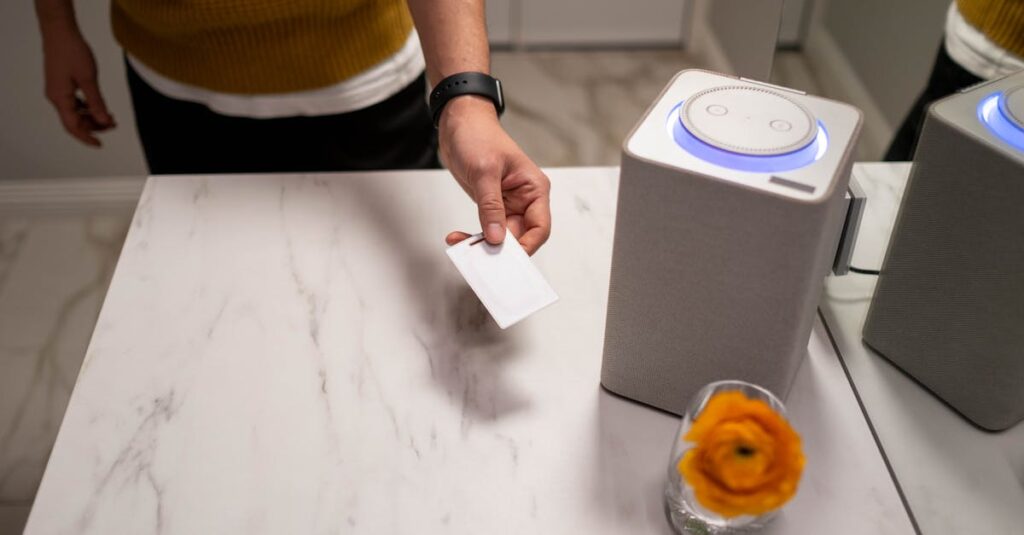Imagine walking into your home and having it greet you like a loyal butler. Home automation controllers are the tech-savvy sidekicks that make this dream a reality. These nifty devices take charge of lighting, heating, security, and even your morning coffee, all while you sit back and relax. Who knew controlling your home could feel like being the star of a sci-fi movie?
In a world where smart homes are no longer just a fantasy, home automation controllers are the brains behind the operation. They streamline daily tasks and boost energy efficiency, making life easier and more enjoyable. With the right controller, your home can adapt to your lifestyle, turning mundane routines into seamless experiences. Get ready to embrace the future and discover how these gadgets can transform a house into a home that’s not just smart, but downright genius.
Table of Contents
ToggleOverview of Home Automation Controllers
Home automation controllers serve as essential tools in managing various functions within a smart home. These devices simplify operation across systems for enhanced comfort and efficiency.
Definition and Purpose
Home automation controllers act as central hubs for automating household tasks. Their purpose involves connecting devices like lights, thermostats, and security cameras to provide seamless control. By integrating various systems, these controllers allow users to manage their homes through apps or voice commands. Enhanced convenience and increased energy savings represent key benefits of utilizing these devices. Controllers facilitate synchronization between different products, improving the overall smart home experience.
Types of Controllers
Several types of home automation controllers exist, catering to varying needs and preferences. Hub-based controllers serve as centralized systems. They connect to multiple devices and provide a single point for management. Cloud-based controllers, on the other hand, leverage internet connectivity to access devices remotely. Voice-activated controllers integrate with virtual assistants, allowing users to issue commands verbally. Additionally, mobile app-based controllers enable hands-on management through smartphones or tablets. Each type offers unique advantages, making it essential for users to choose one that fits their requirements.
Features of Home Automation Controllers
Home automation controllers offer diverse features that enhance usability and efficiency in smart homes. Users appreciate the intuitive interfaces, compatibility with multiple devices, and the capability to customize settings for unique needs.
User Interface Options
Home automation controllers feature user-friendly interfaces that simplify navigation. Dashboards provide clear views of connected devices. Many options include touchscreen displays, mobile apps, and voice commands that allow users to control systems seamlessly. Each interface caters to different preferences, ensuring accessibility for all types of users.
Compatibility with Devices
Controllers support a wide range of devices, making them versatile. Common devices include lights, thermostats, sensors, and security cameras. Compatibility often extends to both Wi-Fi enabled products and Z-Wave or Zigbee devices. Users can efficiently integrate various technologies into one system, fostering a cohesive smart home environment.
Customization and Automation Capabilities
Customization options enable users to tailor their home environments. Automation capabilities allow for personalized schedules and routines, such as adjusting room temperatures or dimming lights at specific times. Users can set triggers based on sensors or calendars, making their smart homes respond intelligently to daily activities and personal preferences.
Popular Brands and Models
Several brands and models dominate the home automation controller landscape, each offering unique features and capabilities.
Brand A
Brand A is recognized for its user-friendly interfaces and robust ecosystem. This brand supports voice commands and integrates well with various smart home devices like lights and thermostats. Customers often highlight its intuitive mobile app, which allows users to manage their home from anywhere. Model X by Brand A stands out for its advanced automation features, enabling users to create custom schedules effortlessly. Its compatibility with Zigbee devices enhances its functionality, making it a preferred choice for many homeowners.
Brand B
Brand B focuses on seamless connectivity and efficiency in home automation. Known for its versatility, this brand works with numerous third-party devices, expanding its user base significantly. Model Y offers a touchscreen display that simplifies navigation while providing critical information at a glance. The brand’s commitment to energy efficiency resonates with eco-conscious users, as its controllers enable detailed monitoring of energy consumption. Customers appreciate the reliability of Brand B, particularly for its extensive support and updates.
Brand C
Brand C is a popular choice for tech enthusiasts seeking advanced functionality. This brand features a cloud-based system, allowing users to control their devices remotely with ease. Model Z is equipped with state-of-the-art security features, ensuring peace of mind for users. Its compatibility with Wi-Fi and Bluetooth devices creates an integrated smart home experience. Feedback from users often mentions the brand’s strong community support, which provides valuable resources for troubleshooting and optimizing setups.
Pros and Cons of Home Automation Controllers
Home automation controllers offer various benefits and drawbacks for users. Understanding these aspects aids in making informed choices.
Advantages
Home automation controllers simplify daily tasks. They enable convenient management of multiple smart devices from a single interface. Enhanced energy efficiency leads to reduced utility bills, benefiting homeowners financially. Users enjoy personalized settings, tailored to daily routines and preferences. Also, these devices enhance home security by coordinating surveillance systems and alerts. Compatibility with diverse products ensures seamless integration into various smart homes. Many controllers are intuitive, offering user-friendly interfaces for quick navigation.
Disadvantages
Initial costs for home automation controllers can be high. Not all devices are compatible, leading to potential gaps in functionality. Maintenance may require periodic updates or troubleshooting. Some users find complex features overwhelming, which can hinder adoption. Additionally, reliance on internet connectivity can pose issues during outages. Privacy concerns arise from data collection by manufacturers, adding layers of caution for users. Overall, the potential for obsolescence exists as technology evolves rapidly, possibly outdating current systems.
Home automation controllers represent a significant leap toward a smarter living environment. By connecting various devices and enhancing user experience they simplify daily tasks while promoting energy efficiency. As technology continues to evolve these controllers will only become more integral to modern homes.
Exploring the diverse options available allows users to find the perfect fit for their needs. Whether prioritizing ease of use or advanced features there’s a controller that can transform any house into a truly intelligent home. Embracing this technology not only enhances convenience but also paves the way for a more sustainable lifestyle.





